It’s no surprise that Donna Zagotta and Carla O’Connor would be drawn together. Both are noted watermedia figure painters who not only search for a personal connection to their subjects but a personal expression of them as well. So what happened when these two friends got together and recorded the conversation? Find out in this unique artist-to-artist interview.
Donna Zagotta: Carla, what do you think makes a great painting?
Carla O’Connor: It is the ability of the artist to convey a message or communicate a unique and personal vision. Regardless of perfect technical skill or mastery of style, a great painting must invoke an emotional, visceral response in the viewer that leaps into the imagination and stirs the heart.
DZ: Are your paintings mainly based on direct observation, photography, memories, or
imagination? In other words, how do you find ideas and inspiration for your paintings?
CO: I use all — observation, photography, memories, and imagination — for inspiration. Some new ideas come out of the blue when I am least expecting it and others are possibly related to an event such as a visit to a museum or a trip to distant lands. More personal experiences are also an important source of inspiration — a major move, birth, death, loss, and joy — all can contribute to the content of the work. I feel that most truly non- objective paintings are inspired by pure emotion.
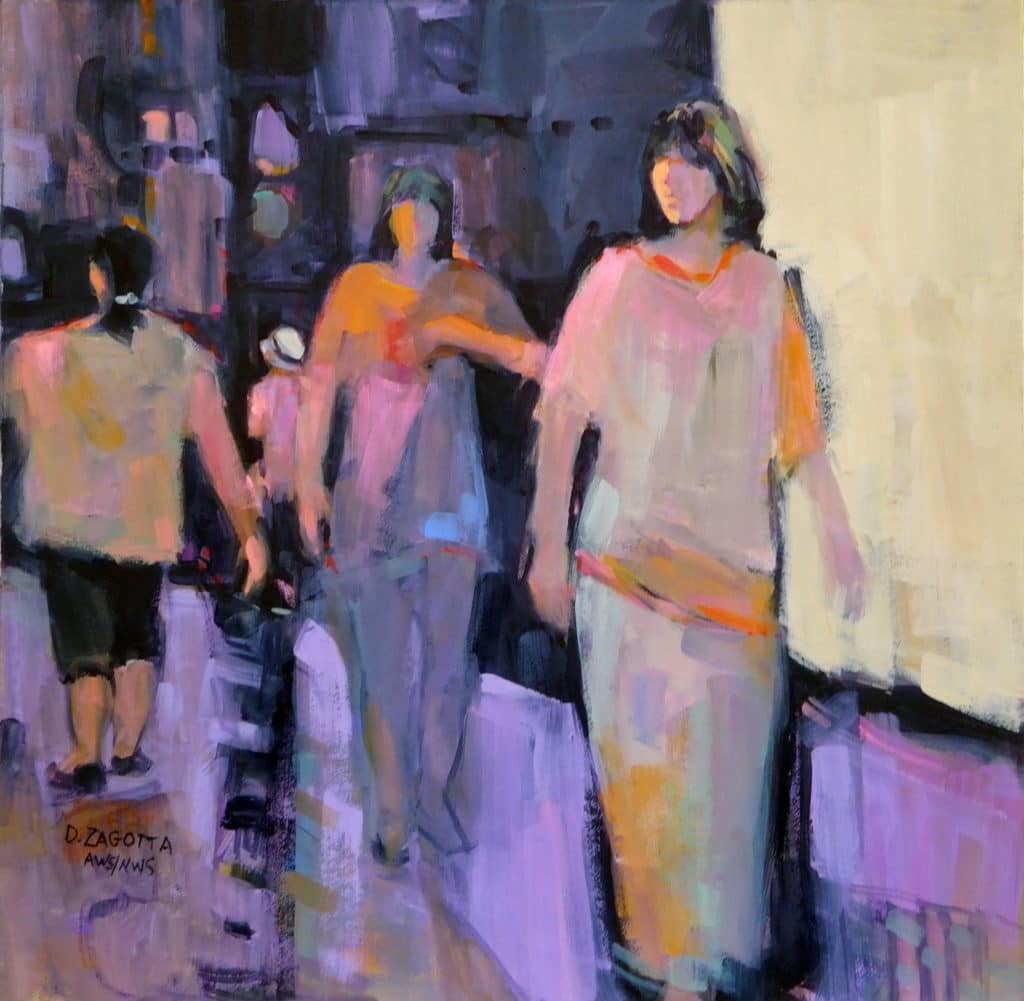
DZ: What is your working process? Why do you prefer gouache as an opaque medium rather than oils or acrylics?
CO: I am a direct painter, very old school. Many years of training in oils taught me to paint thin to thick, light to dark, big to small. I do not draw with a pencil first but with a brush directly on the surface. I do very quick, small thumbnail studies for composition only. I have never been one for visualizing the finished painting beforehand. With only a very rough idea to start, I prefer to be surprised, hopefully a number of times, and frequently challenged through the entire process. I consider gouache to be my mature medium because of its similar handling to oils. It is as if I have come full circle (oil to acrylic to watercolor to gouache) and found the medium that conveys my vision the best.
DZ: Are you a slow or fast painter?
CO: I start by blocking in the big, simple shapes of the composition using a round brush. Then, I work big, loose, thin color and repeated textural effects. I try to get something happening on the surface to play with. With each layer, I begin to slow down and become more selective and controlled. I allow the painting to rest on an easel in different light conditions in order to study it in its entirety. The refinements, additions, and deletions come at the end stage. All tiny details are saved for the very last.

DZ: What are some of your most important composition and design considerations?
CO: Through years of experience, I have come to the conclusion that composition is the most important factor of a painting. All the finest skill and technique in the world will not save a poorly composed painting. Knowledge of the purpose and the use of deliberate and thoughtful formats is real power to an artist. It can pull the viewer in and hold their attention. Knowing what to take out or what to add is critical.
DZ: The color palettes in your paintings have a sophisticated and quiet elegance. How do you choose the colors for your paintings?
CO: I do not consider myself a colorist and have never taught color theory. I prefer soft warm grays and save pure color for a punch or accent in the composition. Color seems to be ever more brilliant when surrounded by grays. The chemical properties of gouache require that you must mix thoroughly to avoid streaking. I never worry about the wrong color choice since gouache is sitting on the surface and can easily be lifted and changed. Also gouache dries darker as opposed to transparent watercolor, which dries lighter. I am often surprised, and sometimes disappointed, at the final tone. But therein lies the challenge!
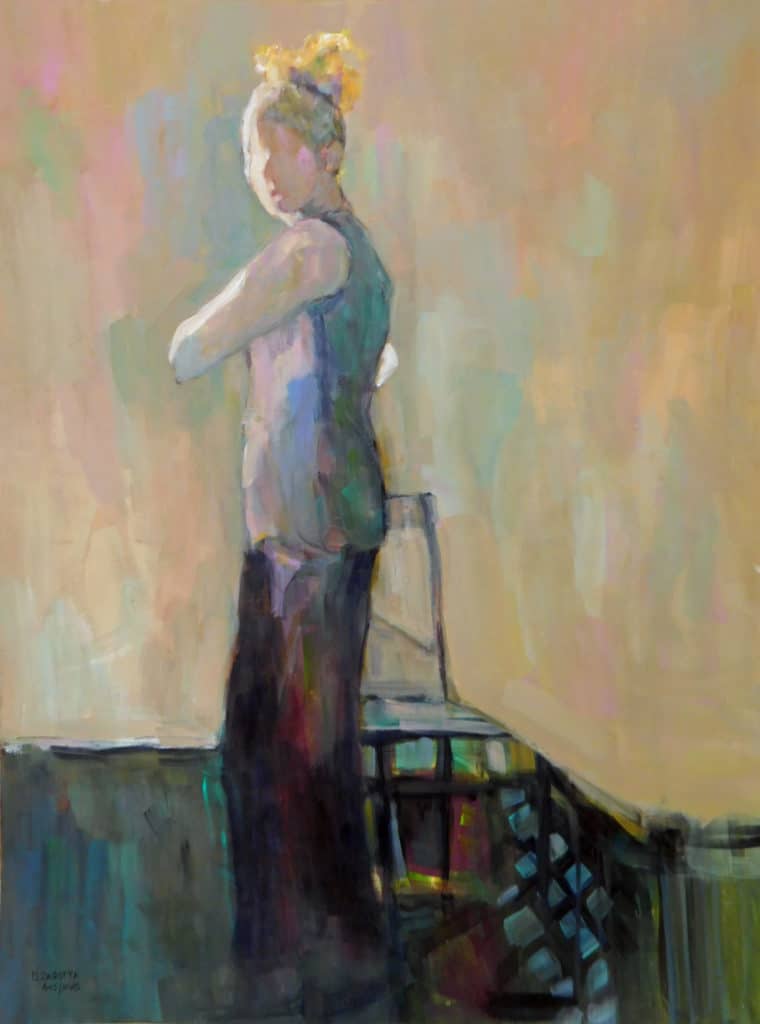
DZ: You have been painting the figure for many years, and your paintings have a decidedly contemporary point of view. What fascinates you about the figure and how do you achieve that contemporary slant?
CO: All my training in college and post-graduate study has been life drawing and figure- based work. It is the ‘thing’ I know best from the inside out. As with any subject, you must be able to draw it realistically in order to then abstract it convincingly. My aim is to depict the three-dimensional human form on a two-dimensional surface. By flattening shapes in and around the figure, I hope to be successful. This combination of real and abstract gives the work a contemporary look and encourages the viewer to participate in the process.
DZ: How did you develop your unique voice and your own way of looking at things?
CO: An artist’s personal ‘voice’ is the unique and recognizable style that is distinctly their own. It is imperative if one wants to teach, publish, sell, or exhibit, especially internationally in today’s world. It is crucial to be known for something particular. I believe we are a culmination of all we have ever heard, read, seen, or been exposed to. Finding your voice is a process of filtering, editing those influences and fully understanding yourself and what you want to say.
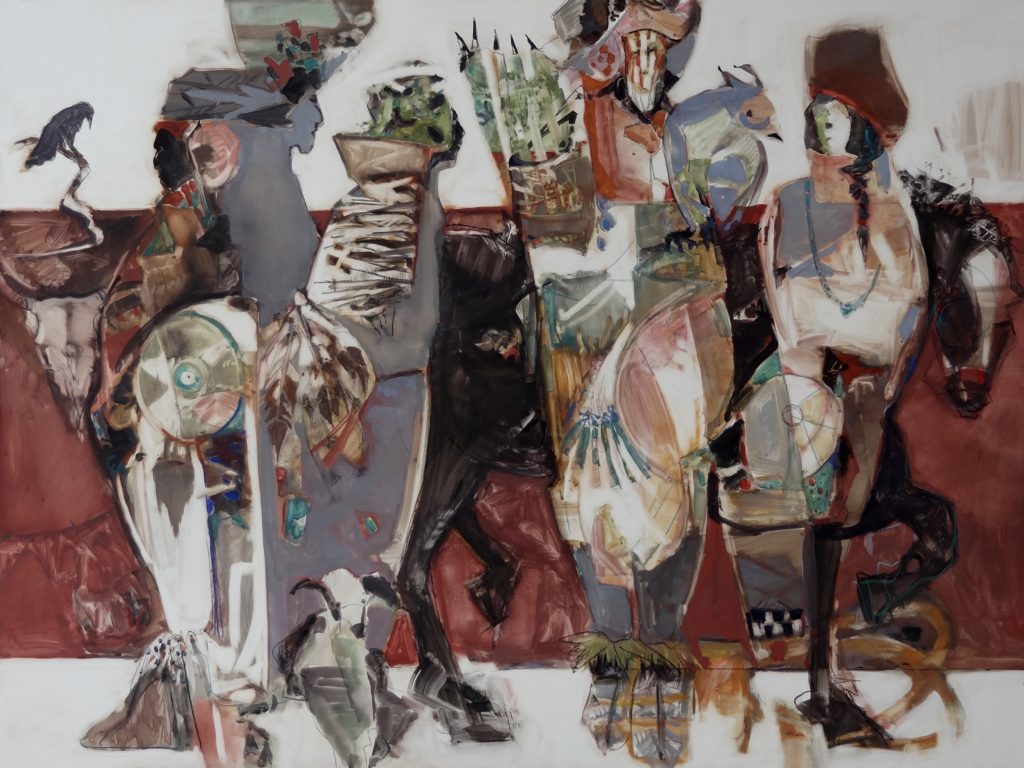
DZ: Your new work is on Claybord and is also on a much larger scale than traditional watercolor paintings. How have those modifications changed your work and/or your working process?
CO: Working large is not new to me. I enjoy the physical aspect and the scale. When the format is small, I find I tighten up my grip on the brush and the resulting image shows tension. Claybord is so smooth, it is like painting on porcelain, which only enhances the lifting properties of gouache. The treated panels are rigid and strong and will stand on an easel as opposed to a flat painting surface. This can be particularly helpful when working with the figure for accuracy and avoiding any distortion.
DZ: How do you deal with the distractions and disruptions inherent in everyday life? In other words, how do you balance everyday life with your painting life?
CO: It has been my habit for years to attend to all domestic issues of everyday life first thing in the morning. When all is done I feel free to go to the studio for the remainder of the day. Lately, I find it is not so much how many hours are spent but the quality of the time. Two or three hours of very focused work can be more productive than six hours of messing around cleaning the studio. Our lives are multifaceted and complicated, sometimes messy and often unpredictable. That is what makes art interesting.
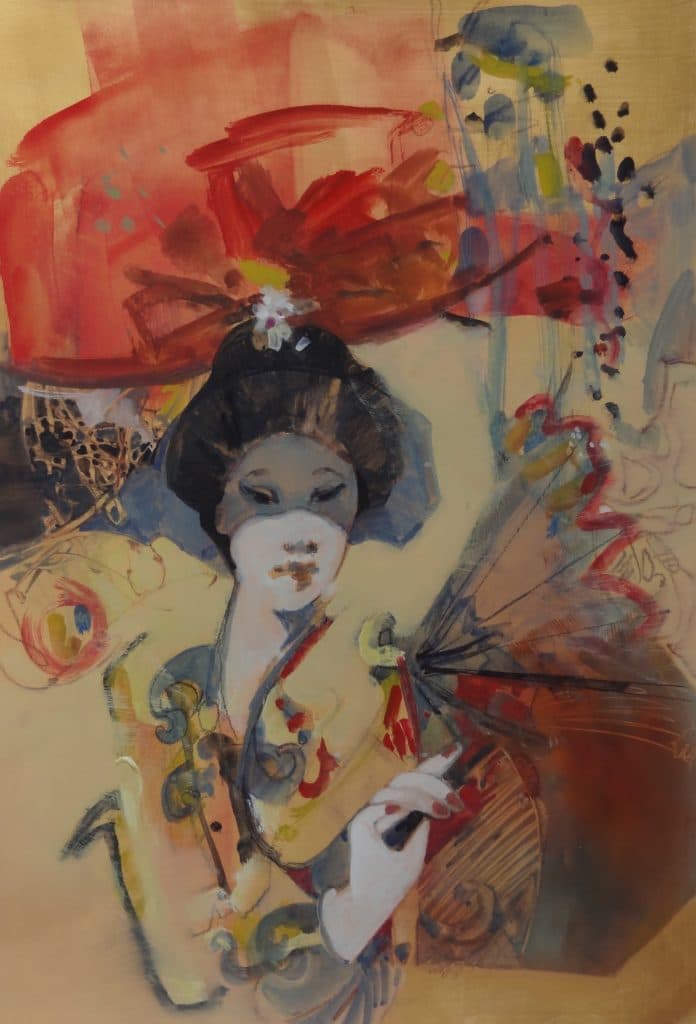
DZ: Can you describe an ideal day in the studio for you?
CO: Years ago, I wished there was a slot under my studio door where I could slide finished paintings out and someone on the other side would slide a dinner tray back to me. All I wanted to do was paint! Needless to say, that didn’t happen and I no longer wish for it. Every season of our lives has a tempo — a beginning song and a finale — I have learned that any time in the studio is precious. Whether it’s 20 minutes or 20 hours, make the most of it!
DZ: How do you refill the well when it’s empty?
CO: Occasionally the well will be empty. No ideas, no inspiration, no nothing! It happens! Many books, articles, and studies have been written about ‘Artist Block’. Everything from laziness, health issues, fear and guilt to distractions and talking too much have been blamed. I imagine that every artist experiences a block at some time or other. I have recently had a major change in my career path that has had an impact on my creative energy. It has been the inevitable ending of one cycle and the transition into a new state of circumstances. I am learning to accept the necessity of these “endings” and looking forward to the change and renewal of purpose. I have no idea where this new cycle will lead in my art journey but have faith in what the future has in store.
DZ: What advice would you give to someone who wants to become a serious watercolor artist?
CO: Paint as much as possible! Enter every show, starting local, then regional, moving to
national, and eventually international. Each step builds your name, your reputation, and your ‘voice.’ Expect rejection at every level. Get mad and then get back to work. Stay focused and hold on to your passion. Remember to breathe!
Donna Zagotta is a nationally recognized artist, teacher, and juror. Carla O’Connor is a signature member of the American Watercolor Society, National Watercolor Society and Northwest Watercolor Society and is an AWS Dolphin Fellow.
For more inspiring stories like this one, sign up for our free weekly e-newsletter.

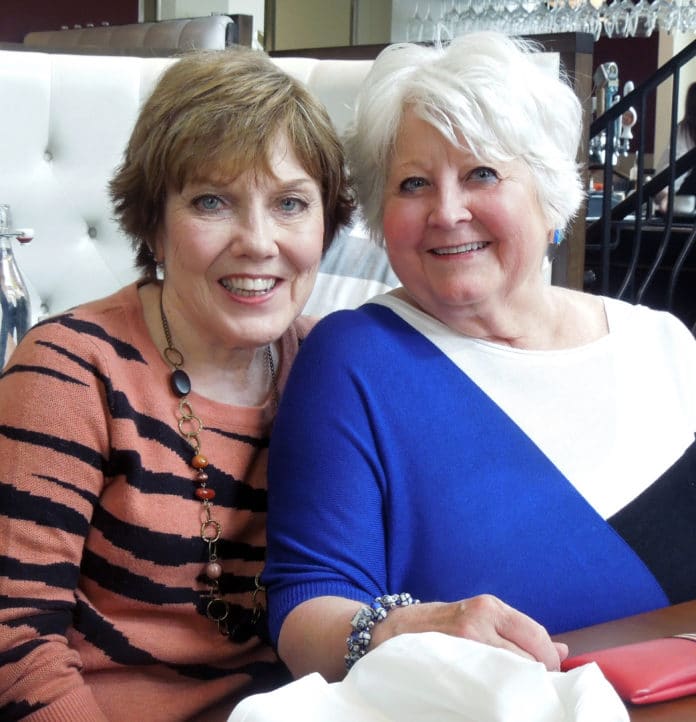







Love love love Carla O’Connor❤️
I’m certainly curious what type i changes
She is making; can’t wait to find out!
I know it will be fabulous…
Love these women’s paintings…if only
What a treat to be invited into this conversation between two of my favorite artists and teachers. Thank you for sharing!
I’m a long-time fan of Carla O’Connor’s work, and glad to see this article in your post. Her work is unique to her, and her vision of the final product of this talent is always an entrancing, involving piece of art.
Thanks so much for the space and the insights you’ve recorded here.
Thank you for providing this conversation. It is wonderful to recognize and be patient with the quiet times in your process. Like a wave drawing away from the shore, the resounding crash of joy will follow faithfully.